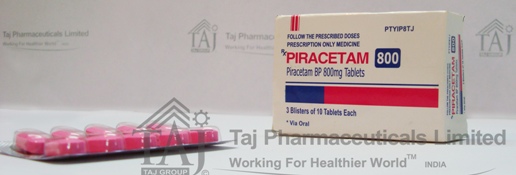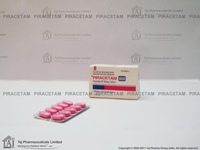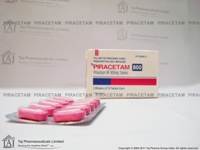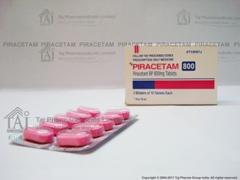|
 Drug form and composition :
Drug form and composition :
Solution for injection. One ampoule of 5 ml contains 1 g Piracetam
(200 mg/ml). Film-coated tablets. One tablet contains 400 mg of
Piracetam.
 Indications :
Indications :
Piracetam, solution for injection is used in cases of severe brain
diseases: cerebro-cranial trauma in acute stage, comatose states,
ischemic stroke, acute psychic disturbances due to intoxications,
alcohol delirium. Piracetam tablets are used in cerebro-vascular
disease; degenerative cortical dementia (Alzheimer’s disease);
senile psychoorganic syndrome (“aging brain”); cortical myoclonia;
dyslexia of vascular and other origin; vestibulopathies;
protection of the nervous tissue in a brain hypoxia; postoperative
deliriums.
 Dosage and administration :
Dosage and administration :
Adults: Parenteral administration. The drug is administered
intramuscularly, as a drop intravenous or as a slow intravenous
infusion. The recommended 24-hours dose is 3 - 12 g (depending on
the severity of the disease) which should be divided in 2-4 takes.
Oral administration. Starting dose - 800 mg (2 tablets), 3 times
daily. After the desired effect has been achieved the dose can be
reduced to 400 mg (1 tablet), 3 times daily. Children: 400 mg 2 or
3 times daily. Administration of the drug after 04:00 h P.M.
should be avoided because of its exciting action and the
possibility of disturbing the night sleep of the patient. The
duration of the treatment course is 2 - 3 months, but in severe
cases the drug can be used for a period of 6 - 12 months.
 Contraindications
Contraindications
First trimester of pregnancy; severe parenchymal liver or kidney
diseases; agitated depression, particularly in the elderly.
|
 |
 Special warnings and precautions :
Special warnings and precautions :
In patients suffering from liver diseases, a monitoring of the
liver enzymes and function is necessary. In patients with renal
failure, the 24-hours dose should be adjusted according to the
creatinine clearance. The levels of the residual nitrogen and
creatinine should be checked regularly. Because of the
distribution into breast milk the breast-feeding should be
discontinued for the period of the treatment.
 Drug interactions :
Drug interactions :
Piracetam increases the effects of the drugs stimulating the CNS,
thyroid hormones and oral anticoagulants. The concurrent
administration of neuroleptics increases the risk of hyperkinesia.
 Adverse reactions :
Adverse reactions :
Rarely in susceptible patients can be observed the following
symptoms: increased aggressiveness, headache, sleep disturbance,
gastrointestinal problems, blood pressure instability.
 Pharmacological mechanisms :
Pharmacological mechanisms :
Piracetam is a nootropic agent. It improves the metabolic
processes in the brain cells, possesses an antihypoxic action,
accelerates the reparative processes in functionally damaged cells
after traumas, intoxications, and stoke. Piracetam acts
selectively on the telencephalon, improving its associative
functions. The drug has an antiplatelet and a microcirculation
ameliorating action. The therapeutic effect of Piracetam is
manifested after prolonged treatment (several weeks to several
months).
 Wallpapers :
Wallpapers :
|

|

|
|
CLICK ON PHOTO TO SEE LARGE |
|









